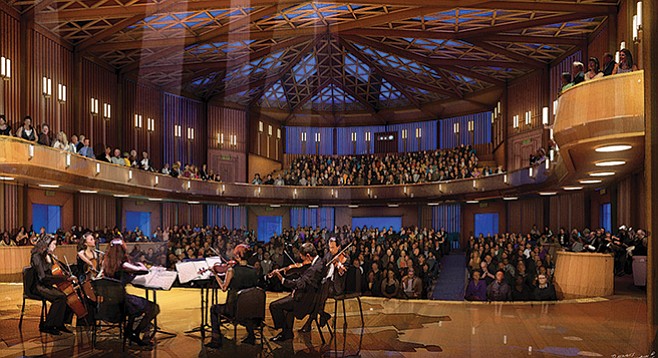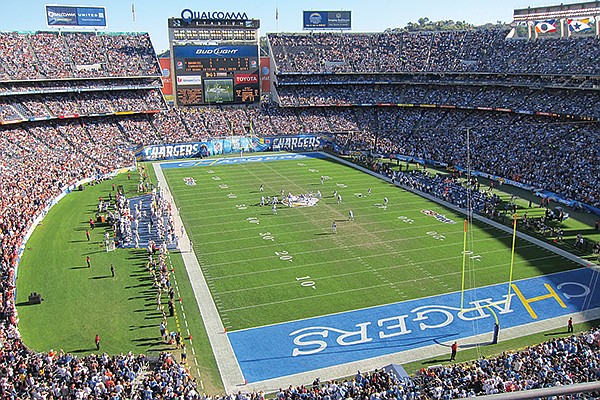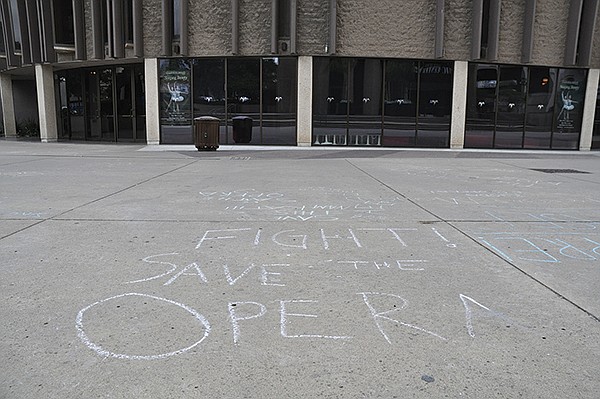 Facebook
Facebook
 X
X
 Instagram
Instagram
 TikTok
TikTok
 Youtube
Youtube

There is a battle in our society: jockstraps versus aesthetes; violence versus violins. The struggle is between lovers of sports and lovers of the arts.
Sorry to say, but nationwide, sports are winning big over the arts. Numerous polls show public interest in spectator sports rising and public interest in arts falling.
But there is at least one metro area in which spectator sports may be headed for a bit of a well-deserved pratfall and the arts (classical music, ballet, visual arts, etc.) seem to be rising in public esteem.

That metro area is San Diego County. There are signs that its love of athletics is waning while its appreciation of the arts rises.
According to the National Endowment for the Arts, the percentage of U.S. adults who attended at least one of various types of arts performances or visited an art museum or gallery dropped from 39 in 1982 to 33.3 in 2012. The percentage of adults who attended a classical music performance at least once plummeted from 13 in 1982 to 8.8 in 2012.
Less than 3 percent of recorded albums sold in 2013 were of classical music. Rock music took 35 percent. Remember the opera simulcasts of the 1970s in San Diego? The public TV station televised the opera, while a local classical music station broadcast the sound. It was glorious. It is long gone.

In the 1970s, general directors of San Diego Opera, when questioned by boardmembers about the large number of elderly folks in the audience, would give assurances that middle-aged folks would soon begin attending opera and replace the old, infirm, and deceased. By the 1990s, the general directors were no longer saying that. Middle-agers were not taking up opera. Indeed, the National Endowment for the Arts found that the biggest decline of arts attendees was among the 45-to-54 age group. About 46 percent of these middle-agers attended at least one arts event in 2002. By 2008, that was down to 36 percent (although the economy had also taken a huge hit in 2008).
But look at sports. According to San Francisco’s research firm WR Hambrecht & Co., between 2007 and 2011, ticket prices in the National Football League and Major League Baseball were going up at a 4 percent compound annual rate. Surprisingly, from late 2007 to early 2009, the nation was suffering the worst economic setback since the 1930s Depression.
According to Forbes magazine, the North American sports market will grow from $60.5 billion in 2014 to $73.5 billion in 2019. Sports media rights will propel this growth. They will go up from $14.6 billion to $20.6 billion between 2014 and 2019 — an amazing 7.2 percent compound annual growth rate.
So, the trend is clear: sports up, arts down. But, whoa, Nelly. San Diego is somewhat of an exception. San Diego Symphony was founded in 1910, suspended in the 1920s, disbanded in 1936, restarted in 1949, and went silent and bankrupt in 1996. But in 2002, it got a $120 million gift from Joan and Irwin Jacobs, to be spread out over several years.
In September of this year, the symphony was able to announce a new contract with musicians; over a five-year period, base pay will rise from $70,000 to $80,000. Ten years ago, the base was $46,000. The current budget is around $22 million. This puts San Diego Symphony in the Group 1 category among America’s top orchestras, as ranked by the League of American Orchestras.
Not everything is glorious. Total concert revenue inched down from 2014 to 2015. But costs were cut even more. The symphony has filled seats by putting more emphasis on pop music. This year’s summer season set an all-time record for tickets sold by featuring a tribute to the Beatles and performances by Diana Ross and jazz trumpeter Chris Botti. Summer concerts have always featured popular music, but the symphony is going heavier on pops during the regular season, too.

“Theater is booming here,” says John Patrick Ford, local arts columnist. Groups such as the Old Globe and La Jolla Playhouse, along with many smaller companies, are doing very well. The comedy Meteor Shower, which ran from July 30 to September 18 at the Globe, broke a box-office record, becoming the most successful show in the theater-in-the-round space, selling almost 13,000 tickets and grossing $862,000.
The 1990s were once considered the glory years for San Diego theater. But Hal Fuson, former chairman of the Old Globe, a current boardmember, and a subscriber for 30 years (plus 15 years to the Playhouse), thinks the Globe is now doing better than it did in the 1990s. “My general sense is we couldn’t be in a better theater town. A lot of philanthropic money is coming in” to San Diego theater, says Fuson.
La Jolla Music Society is going gangbusters, too. It was once called La Jolla Chamber Music Society, but it changed its name when it began putting on ballet, jazz, and orchestral and cabaret performances. Money is flowing in, audiences are burgeoning, and the society is building a new performance venue, the Conrad Prebys Performing Arts Center, at 7600 Fay Avenue.
San Diego Opera, consistently ranked among the nation’s top ten companies by OPERA America, hit an iceberg in 2014, when the board suddenly decided the company would go out of business. But among public howls, the board eventually reversed the vote, and the company, flush with generous gifts, had a successful 2015 season. It suffered a bit of an operating loss, but it is looking forward to a strong 2016–2017 season.
It will do three old warhorses (mainly 19th-century grand opera) in the Civic Theatre but will do two modern operas and one recital in the smaller Balboa Theatre. The idea is to attract a younger audience. The company is doing a revised and shortened version of the opera Carmen that follows the plot of the novella that the original opera was based on. “Carmen is a prostitute. Don José is a serial killer. The toreador, Escamillo, gets gored to death in a bullfight,” says Ford. “It’s pretty gritty.”
Pretty gritty? How about spectator sports in San Diego? The Padres have had a horrible season. The Chargers had one last year and may have another one this year — but, most importantly, may decisively lose the November vote in which the team is trying to get a fat subsidy for a new downtown stadium.
It certainly appears that pro sports in San Diego are going down while the arts are on the rise. How many metro areas can say that?


There is a battle in our society: jockstraps versus aesthetes; violence versus violins. The struggle is between lovers of sports and lovers of the arts.
Sorry to say, but nationwide, sports are winning big over the arts. Numerous polls show public interest in spectator sports rising and public interest in arts falling.
But there is at least one metro area in which spectator sports may be headed for a bit of a well-deserved pratfall and the arts (classical music, ballet, visual arts, etc.) seem to be rising in public esteem.

That metro area is San Diego County. There are signs that its love of athletics is waning while its appreciation of the arts rises.
According to the National Endowment for the Arts, the percentage of U.S. adults who attended at least one of various types of arts performances or visited an art museum or gallery dropped from 39 in 1982 to 33.3 in 2012. The percentage of adults who attended a classical music performance at least once plummeted from 13 in 1982 to 8.8 in 2012.
Less than 3 percent of recorded albums sold in 2013 were of classical music. Rock music took 35 percent. Remember the opera simulcasts of the 1970s in San Diego? The public TV station televised the opera, while a local classical music station broadcast the sound. It was glorious. It is long gone.

In the 1970s, general directors of San Diego Opera, when questioned by boardmembers about the large number of elderly folks in the audience, would give assurances that middle-aged folks would soon begin attending opera and replace the old, infirm, and deceased. By the 1990s, the general directors were no longer saying that. Middle-agers were not taking up opera. Indeed, the National Endowment for the Arts found that the biggest decline of arts attendees was among the 45-to-54 age group. About 46 percent of these middle-agers attended at least one arts event in 2002. By 2008, that was down to 36 percent (although the economy had also taken a huge hit in 2008).
But look at sports. According to San Francisco’s research firm WR Hambrecht & Co., between 2007 and 2011, ticket prices in the National Football League and Major League Baseball were going up at a 4 percent compound annual rate. Surprisingly, from late 2007 to early 2009, the nation was suffering the worst economic setback since the 1930s Depression.
According to Forbes magazine, the North American sports market will grow from $60.5 billion in 2014 to $73.5 billion in 2019. Sports media rights will propel this growth. They will go up from $14.6 billion to $20.6 billion between 2014 and 2019 — an amazing 7.2 percent compound annual growth rate.
So, the trend is clear: sports up, arts down. But, whoa, Nelly. San Diego is somewhat of an exception. San Diego Symphony was founded in 1910, suspended in the 1920s, disbanded in 1936, restarted in 1949, and went silent and bankrupt in 1996. But in 2002, it got a $120 million gift from Joan and Irwin Jacobs, to be spread out over several years.
In September of this year, the symphony was able to announce a new contract with musicians; over a five-year period, base pay will rise from $70,000 to $80,000. Ten years ago, the base was $46,000. The current budget is around $22 million. This puts San Diego Symphony in the Group 1 category among America’s top orchestras, as ranked by the League of American Orchestras.
Not everything is glorious. Total concert revenue inched down from 2014 to 2015. But costs were cut even more. The symphony has filled seats by putting more emphasis on pop music. This year’s summer season set an all-time record for tickets sold by featuring a tribute to the Beatles and performances by Diana Ross and jazz trumpeter Chris Botti. Summer concerts have always featured popular music, but the symphony is going heavier on pops during the regular season, too.

“Theater is booming here,” says John Patrick Ford, local arts columnist. Groups such as the Old Globe and La Jolla Playhouse, along with many smaller companies, are doing very well. The comedy Meteor Shower, which ran from July 30 to September 18 at the Globe, broke a box-office record, becoming the most successful show in the theater-in-the-round space, selling almost 13,000 tickets and grossing $862,000.
The 1990s were once considered the glory years for San Diego theater. But Hal Fuson, former chairman of the Old Globe, a current boardmember, and a subscriber for 30 years (plus 15 years to the Playhouse), thinks the Globe is now doing better than it did in the 1990s. “My general sense is we couldn’t be in a better theater town. A lot of philanthropic money is coming in” to San Diego theater, says Fuson.
La Jolla Music Society is going gangbusters, too. It was once called La Jolla Chamber Music Society, but it changed its name when it began putting on ballet, jazz, and orchestral and cabaret performances. Money is flowing in, audiences are burgeoning, and the society is building a new performance venue, the Conrad Prebys Performing Arts Center, at 7600 Fay Avenue.
San Diego Opera, consistently ranked among the nation’s top ten companies by OPERA America, hit an iceberg in 2014, when the board suddenly decided the company would go out of business. But among public howls, the board eventually reversed the vote, and the company, flush with generous gifts, had a successful 2015 season. It suffered a bit of an operating loss, but it is looking forward to a strong 2016–2017 season.
It will do three old warhorses (mainly 19th-century grand opera) in the Civic Theatre but will do two modern operas and one recital in the smaller Balboa Theatre. The idea is to attract a younger audience. The company is doing a revised and shortened version of the opera Carmen that follows the plot of the novella that the original opera was based on. “Carmen is a prostitute. Don José is a serial killer. The toreador, Escamillo, gets gored to death in a bullfight,” says Ford. “It’s pretty gritty.”
Pretty gritty? How about spectator sports in San Diego? The Padres have had a horrible season. The Chargers had one last year and may have another one this year — but, most importantly, may decisively lose the November vote in which the team is trying to get a fat subsidy for a new downtown stadium.
It certainly appears that pro sports in San Diego are going down while the arts are on the rise. How many metro areas can say that?
Comments